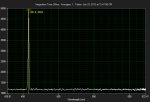rhd
0
- Joined
- Dec 7, 2010
- Messages
- 8,469
- Points
- 0
We've all been a little skeptical of the "460nm" diodes that have appeared in a few places online and here on LPF. An owner of one of the "460nm" labbies has one en-route to me now to have it's wavelength tested, and I'll let everyone know my findings when it arrives.
But as an interim update, I'll say that I'm not nearly as skeptical of this claim as I was a month ago.
I've been testing and binning a lot of diodes in an attempt to find something approaching 460. I'm not there yet, but after 60 diodes, I've found one that has come fairly close:

It's 458nm, and it takes a full current of 1.8A to get there. So it's not quite 460, and certainly would be another nanometer or two further away if I was only running it at the ~1A that we've heard of these other "460s" operating at. That said, it's pretty close.
This particular diode came out of an M240, and it was by far the highest wavelength I've seen out of 24 pcs from an M240, 12 pcs from DTR (M140), 15 pcs from an A145, and 3 others that I didn't have projector origins recorded for (certainly A series though).
So, in theory, if the Chinese are binning diodes, these 460s are more than realistic. It took me almost 60 diodes to find a 458. Some of the Chinese outfits making cheap Lazerer/LasersMan/YourLasers pointers are surely deeling with hundreds and hundreds of diodes a day. If just one enterprising employee thought to ask their boss for a spectrometer, chances are good that they'd find a 460 fairly regularly.
So, with that said, it would be awesome if Styropyro would finally tell us where he's getting these 460s from (if they end up being 460 when I test the one that's en route). But absent that, I think we can all still expect to see these high wavelengths appearing on LPF from time to time. I'm sure that if someone like DTR grabbed a spectrometer, he'd be able to find a few.
Final Notes:
But as an interim update, I'll say that I'm not nearly as skeptical of this claim as I was a month ago.
I've been testing and binning a lot of diodes in an attempt to find something approaching 460. I'm not there yet, but after 60 diodes, I've found one that has come fairly close:
It's 458nm, and it takes a full current of 1.8A to get there. So it's not quite 460, and certainly would be another nanometer or two further away if I was only running it at the ~1A that we've heard of these other "460s" operating at. That said, it's pretty close.
This particular diode came out of an M240, and it was by far the highest wavelength I've seen out of 24 pcs from an M240, 12 pcs from DTR (M140), 15 pcs from an A145, and 3 others that I didn't have projector origins recorded for (certainly A series though).
So, in theory, if the Chinese are binning diodes, these 460s are more than realistic. It took me almost 60 diodes to find a 458. Some of the Chinese outfits making cheap Lazerer/LasersMan/YourLasers pointers are surely deeling with hundreds and hundreds of diodes a day. If just one enterprising employee thought to ask their boss for a spectrometer, chances are good that they'd find a 460 fairly regularly.
So, with that said, it would be awesome if Styropyro would finally tell us where he's getting these 460s from (if they end up being 460 when I test the one that's en route). But absent that, I think we can all still expect to see these high wavelengths appearing on LPF from time to time. I'm sure that if someone like DTR grabbed a spectrometer, he'd be able to find a few.
Final Notes:
- My approach wasn't to run every diode at 1.8A off the bat. Instead, I ran each diode at lasing current of around 250mA and recorded the wavelengths. Then I separated off the top readings (in that case, it was the diodes that measured 448 and 449 at 250mA). Those were the diodes I pushed to 1.8A. I lost one (the 448) in the process, but the other (the 449) ended up netting me a 458 @ 1.8A of current.
- A lot of people have asked about color, and whether it looks different from normal 445s. This is kind of a funny question, because what's a "normal 445?". Here's my take. If I put this 458 up against another diode in the 450+ range, I can't usually the difference. If it's up against something in the 445 to 450 range, I can. And if it's up against another diode that is 445 or lower, then even a "disinterested 3rd party" (ie, a layman) would spot that the 445 (or lower) was "purply" and the 458 was "cyany".
- Another interesting comparison. If I consciously select a low wavelength like 442, and then put this 458 between the 442 and a 473, the 458 looks closer in colour to the 473 than it does to the 442.
- And finally, according to the relative brightness comparison, a 458 running at 2W of output, should have a beam brightness equivalent to 3,280mW of 445. I can't subjectively confirm this because I haven't actually collimated this 458 yet, but I'm certainly excited to do so. Beam: (458nm 2000mw) vs. (445nm 3280.96mw)





